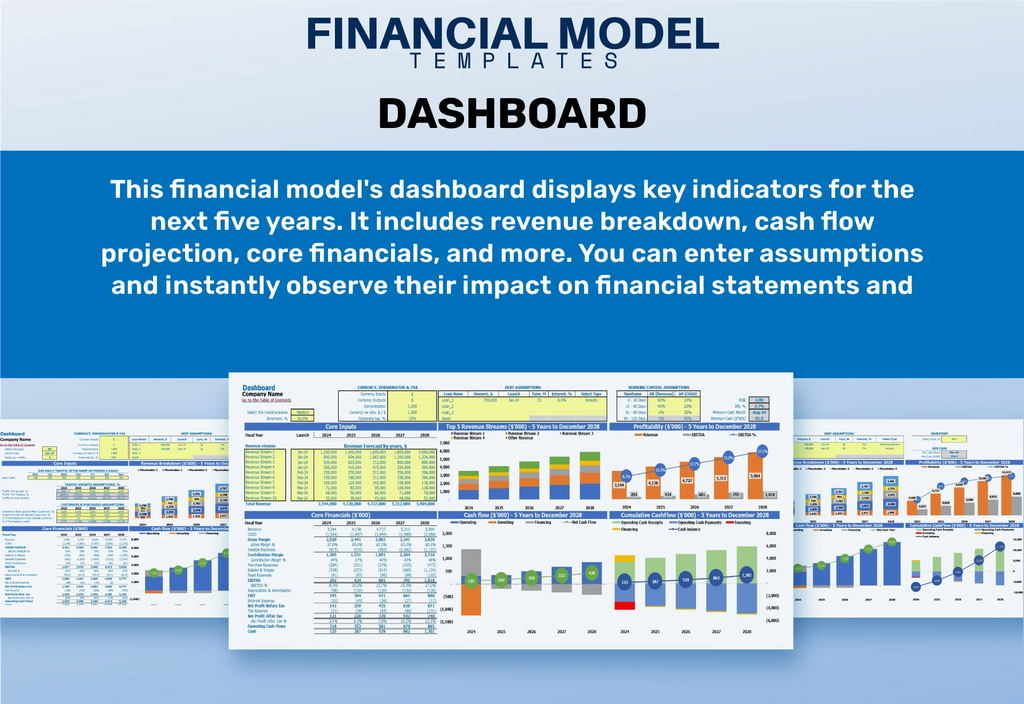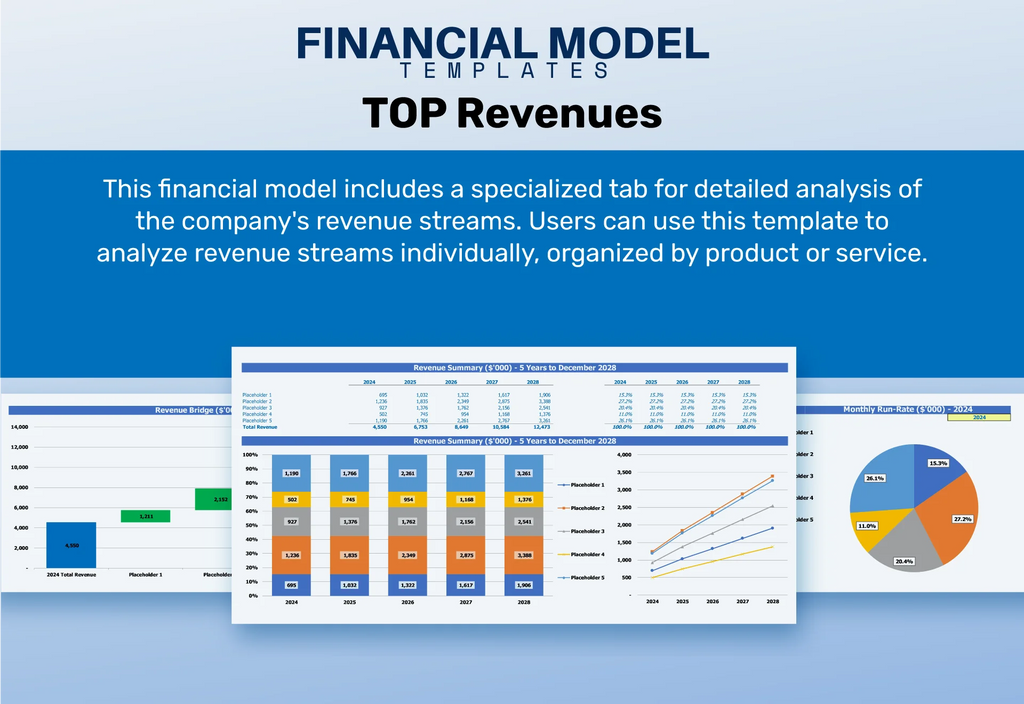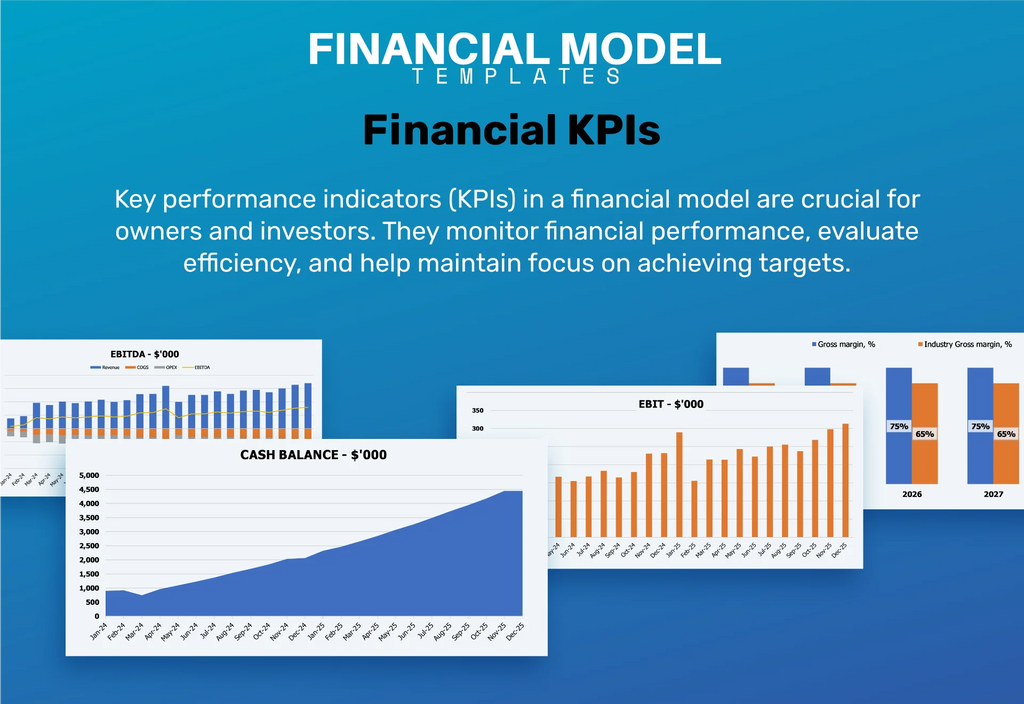Virtual Clothing Try On Service Financial Model

- ✔ 5-Year Financial Projections
- ✔ 100% Editable
- ✔ Investor-Approved Valuation Models
- ✔ MAC/PC Compatible, Fully Unlocked
- ✔ No Accounting Or Financial Knowledge
Virtual Clothing Try On Service Financial Model
Bundle Includes:
ALL IN ONE MEGA PACK - CONSIST OF:
virtual clothing try on service Financial Model/Business Plan Excel Template
Pitch Deck Template For PowerPoint, Keynote & Google Slides
Business Plan Guide and Business Plan Template in MS Word Format
Financial Dashboard in Excel To Track Your Business Performance
VIRTUAL CLOTHING TRY ON SERVICE FINANCIAL MODEL FOR STARTUP INFO
Highlights
The virtual fashion try-on market is rapidly evolving, driven by advancements in technologies such as 3D body scanning and augmented reality fashion try-on solutions. Fashion retailers are increasingly adopting eCommerce virtual try-on tools to enhance customer engagement and optimize the user experience in eCommerce, ultimately leading to strategies for return rate reduction. Innovative clothing size prediction algorithms and AI-driven virtual closet solutions are reshaping online apparel fitting solutions, providing customers with tailored experiences that align with their preferences. As partnerships with clothing brands strengthen and subscription models for virtual fitting emerge, businesses can leverage digital garment visualization tools and analyze the cost associated with virtual fitting services. This landscape presents immense opportunities for scalable virtual try-on platforms, driven by insights into consumer behavior in virtual try-on scenarios and effective merchandise planning in the realm of virtual retail.
The financial model overview addresses key pain points faced by buyers of virtual fitting room technology by providing a comprehensive framework that simplifies cost analysis and optimizes user experience in eCommerce. It includes robust tools for evaluating the scalability of virtual try-on platforms, enabling fashion retailers to enhance customer engagement through augmented experiences while effectively managing merchandise planning. By incorporating clothing size prediction algorithms and 3D body scanning technology, the model aids in return rate reduction strategies, ensuring a higher satisfaction level among consumers. Furthermore, it outlines potential partnerships with clothing brands and explores subscription models for virtual fitting, allowing startups to attract investment by demonstrating how AI-driven virtual closet solutions can significantly impact consumer behavior while streamlining financial strategies. This thorough approach not only assesses financial feasibility but also empowers businesses to present well-supported financial projections that illustrate expected sales trends, customer growth, and average spending per transaction, ultimately making it an indispensable asset in the competitive virtual fashion try-on market.
Description
The financial model for the virtual clothing try-on service includes a comprehensive projected cash flow statement template, specifically designed for businesses leveraging virtual fitting room technology and augmented reality fashion try-on solutions over a five-year forecast period. This dynamic Excel template equips fashion retailers with essential tools for merchandise planning, enabling them to streamline operations without getting bogged down by complex calculations. By focusing on customer engagement through AI-driven virtual closet solutions and clothing size prediction algorithms, businesses can enhance their marketing strategies while significantly optimizing user experience in eCommerce. The model encompasses projected profit and loss statements, balance sheets, and cash flow forecasting, integrating crucial financial performance ratios and KPIs needed to satisfy investor requirements and assess profitability within the evolving virtual try-on market trends.
VIRTUAL CLOTHING TRY ON SERVICE FINANCIAL MODEL REPORTS
All in One Place
A comprehensive financial model integrates essential statements—profit and loss projections, pro forma balance sheets, and cash flow—into a cohesive forecast. While simplified models focus on just one statement, they often fail to present a complete financial picture. By utilizing a full financial model, businesses can engage in scenario planning, gaining insights into how shifts in their business strategy affect profitability, balance sheets, and cash flow. For retail technology firms, this approach is vital for optimizing user experiences, enhancing customer engagement, and ultimately reducing return rates through innovative solutions like virtual fitting room technology and AI-driven virtual closet tools.

Dashboard
This financial projection dashboard is invaluable for engaging stakeholders, potential investors, and lenders. It delivers a comprehensive analysis of your company's financial health, featuring user-friendly charts and actionable insights drawn directly from your Excel reports. By showcasing clear financial forecasts and accounting trends, this tool enhances your presentation, facilitating informed decision-making in the context of retail technology financial strategies. Elevate your discussions around virtual fitting room technology and AI-driven solutions, demonstrating how effective planning can optimize user experience and consumer engagement in the rapidly evolving eCommerce landscape.

Business Financial Statements
Our advanced financial forecasting model features a comprehensive, pre-built structure for primary financial statements, including pro forma balance sheets, profit and loss statements, and cash flow forecasts. Designed for seamless usability, it automatically generates five-year financial projections. The model incorporates essential financial and managerial reports, along with key financial ratios, ensuring robust analysis. Users can conveniently select between GAAP or IFRS formats for their financial data presentation, optimizing their reporting efficiency and enhancing decision-making capabilities in the evolving landscape of virtual fitting room technology and the fashion retail sector.

Sources And Uses Statement
The three-year financial projection template details the company's funding sources and expenditure strategies. By integrating virtual fitting room technology and augmented reality fashion try-on tools, we enhance customer engagement and optimize user experience in eCommerce. Our investment in 3D body scanning technology and clothing size prediction algorithms aligns with current virtual fashion try-on market trends, aiming to reduce return rates. This comprehensive cost analysis supports our partnerships with clothing brands and subscription models for virtual fitting, ensuring scalability and long-term success in the retail sector.

Break Even Point In Sales Dollars
The break-even analysis in this Excel financial model highlights the point at which your company transitions to profitability. It visually represents when overall revenues surpass expenses, essential for strategic planning. By understanding these critical financial metrics, fashion retailers can optimize customer engagement in virtual fitting, leverage AI-driven virtual closet solutions, and develop effective return rate reduction strategies. This insight is crucial for crafting partnerships with clothing brands and fine-tuning merchandise planning in virtual retail, ultimately enhancing scalability and user experience optimization in eCommerce.

Top Revenue
To drive sustainable revenue, fashion retailers must leverage virtual fitting room technology and AI-driven virtual closet solutions. Accurate forecasting of future revenues is crucial; it influences overall enterprise value and impacts financial modeling. By integrating online apparel fitting solutions and clothing size prediction algorithms, companies can optimize user experience and enhance customer engagement in virtual fitting environments. Detailed proforma templates enable management to analyze growth rates based on consumer behavior and market trends, ensuring effective merchandise planning while reducing return rates. Scaling virtual try-on platforms through strategic partnerships can further strengthen financial strategies and boost profitability.

Business Top Expenses Spreadsheet
This five-year forecast template features a comprehensive Top Expenses tab, categorizing costs into four main types, alongside an 'Other' category for varied purposes. By integrating virtual fitting room technology and online apparel fitting solutions, fashion retailers can enhance customer engagement and optimize their user experience in eCommerce. Leveraging AI-driven virtual closet solutions and clothing size prediction algorithms allows for more accurate merchandise planning and a significant reduction in return rates. Explore market trends in virtual fashion try-on while ensuring financial strategies are aligned for scalability and sustainable partnerships with clothing brands.

VIRTUAL CLOTHING TRY ON SERVICE FINANCIAL PROJECTION EXPENSES
Costs
A financial forecasting model is an essential tool for projecting expenses, enabling fashion retailers to pinpoint critical areas for improvement. By utilizing a five-year financial projection template, you can effectively identify vulnerabilities in your business strategy. These projections are crucial for crafting a compelling business plan, helping to secure funding or loans from investors. In an era where augmented reality fashion try-on and 3D body scanning technology transform customer engagement, understanding your financial landscape can enhance user experience optimization and drive successful partnerships with clothing brands. Embrace data-driven insights to navigate the evolving retail technology landscape.

CAPEX Spending
Effective capital allocation is crucial for enhancing a company's competitive edge, particularly in the realm of virtual fitting room technology. By integrating AI-driven virtual closet solutions and 3D body scanning technology, firms can significantly improve customer engagement and user experience optimization in eCommerce. Strategic partnerships with clothing brands and investment in digital garment visualization tools can drive merchandise planning and optimize return rate reduction strategies. Furthermore, cost analysis of virtual fitting services ensures financial viability, positioning fashion retailers to leverage emerging trends in the virtual fashion try-on market and support scalable, innovative solutions.

Loan Financing Calculator
Effective management of loan profiles and repayment schedules is vital for all businesses, particularly startups and growing enterprises. Implementing robust financial infrastructure and software enables detailed tracking of outstanding amounts, maturity dates, and key covenants. A comprehensive loan repayment schedule should clearly outline interest and principal repayments, influencing cash flow forecasts and linking directly to the balance sheet. This transparency allows companies to understand the impact of regular loan expenses on their cash flow statement, ensuring informed financial decision-making and greater user engagement in their financial obligations.

VIRTUAL CLOTHING TRY ON SERVICE EXCEL FINANCIAL MODEL METRICS
Financial KPIs
Gross profit margin is a crucial metric for assessing a company's profitability, calculated by dividing gross profit by net sales. For fashion retailers leveraging virtual fitting room technology, this measure can significantly influence financial strategies. By integrating online apparel fitting solutions and AI-driven virtual closet solutions, businesses can enhance customer engagement and optimize user experience in eCommerce. Ultimately, effective merchandise planning, coupled with robust clothing size prediction algorithms, can lead to reduced return rates, improved profitability, and sustained growth in the rapidly evolving virtual fashion try-on market.

Cash Flow Forecast Excel
Introducing our comprehensive cash flow analysis template, designed for the evolving landscape of online retail. This five-year financial projection tool empowers users to effectively monitor cash flows across operating, investing, and financing categories. Tailored for businesses leveraging virtual fitting room technology and AI-driven virtual closet solutions, it allows for seamless monthly or annual data input. With an emphasis on user experience optimization in eCommerce, this template serves as a vital resource for fashion retailers aiming to enhance customer engagement, reduce return rates, and improve merchandise planning in virtual retail environments. Empower your financial strategy today!

KPI Benchmarks
A financial model template for startups includes a benchmark tab that calculates key performance indicators (KPIs) against industry averages. This benchmarking analysis is vital for financial planning, enabling companies to identify best practices in their sector. By comparing their performance with established standards, businesses can optimize strategies, enhance customer engagement, and improve their overall user experience in eCommerce. This approach is particularly beneficial for fashion retailers adopting advanced technologies like virtual fitting room solutions, which can significantly reduce return rates and streamline merchandise planning.

P&L Statement Excel
To ensure profitability in a virtual fitting room technology startup, a well-structured profit and loss statement is essential for accurately forecasting losses and gains. This financial model is crucial for any emerging business aiming for sustainable growth. Utilizing a five-year cash flow projection template, startups can generate comprehensive annual reports that account for every detail, including after-tax balances and net profits. By strategically analyzing this data, companies can effectively enhance user experience optimization in eCommerce and streamline customer engagement through innovative augmented reality fashion try-on solutions.

Pro Forma Balance Sheet Template Excel
Integrating a balance sheet forecast with a profit and loss statement is essential for assessing the investment required to sustain projected sales and profits. This financial synergy enables fashion retailers to evaluate their future health accurately. By leveraging virtual fitting room technology and eCommerce virtual try-on tools, retailers can enhance customer engagement and optimize user experience. These innovations, coupled with cost analysis and partnerships with clothing brands, pave the way for effective merchandise planning and scalable solutions, ultimately driving growth in the evolving virtual fashion try-on market.

VIRTUAL CLOTHING TRY ON SERVICE FINANCIAL PROJECTION TEMPLATE VALUATION
Startup Valuation Model
The pre-revenue company spreadsheet delivers critical financial insights by incorporating Weighted Average Cost of Capital (WACC), Discounted Cash Flows (DCF), and Free Cash Flows (FCF). WACC, an essential risk assessment metric, provides a weighted analysis of equity and debt, guiding lending decisions. Meanwhile, DCF analysis quantifies future cash flows, crucial for evaluating potential investment opportunities. Together, these metrics underpin robust financial strategies, positioning the company for success in the evolving landscape of virtual fitting room technology and customer engagement in eCommerce.

Cap Table
This financial model business plan is essential for forecasting cash flow and managing income and expenditures effectively. It incorporates a capitalization table, crucial for precise financial projections and evaluating sales and EBITDA. This template supports investors in assessing their investments while optimizing user experiences in eCommerce and enhancing customer engagement. By integrating virtual fitting room technology, fashion retailers can reduce return rates and improve merchandise planning. Utilizing AI-driven solutions and digital garment visualization tools can streamline operations, making your business more attractive to potential partners and enhancing overall scalability in the virtual try-on market.

KEY FEATURES
Adopting subscription models for virtual fitting can significantly reduce return rates and enhance customer engagement in eCommerce.
Implementing a financial model for virtual try-on tools enhances profitability while optimizing customer engagement and reducing return rates.
Implementing AI-driven virtual closet solutions enhances customer engagement, optimizing user experience while reducing return rates and improving profitability.
A robust cash flow forecast can impress lenders by clearly demonstrating your capacity to repay a business loan effectively.
Implementing subscription models for virtual fitting enhances customer engagement while optimizing financial strategies and reducing return rates in eCommerce.
Integrating AI-driven virtual closet solutions enhances financial strategies by optimizing customer engagement and reducing return rates for fashion retailers.
AI-driven virtual closet solutions enhance customer engagement by optimizing user experience, ultimately reducing return rates and improving profitability.
Leverage our 5-Year Financial Projection model to optimize virtual fitting room technology investments, enhancing profitability without complex programming needs.
AI-driven virtual closet solutions enhance customer engagement, optimize user experience, and significantly reduce return rates and operational costs.
Leverage our virtual fitting room technology for cost-effective financial strategies, ensuring optimized returns and enhanced customer engagement in eCommerce.
ADVANTAGES
Leveraging subscription models for virtual fitting enhances customer engagement while optimizing financial strategies and streamlining merchandise planning.
Utilizing subscription models for virtual fitting enhances customer retention and streamlines revenue, benefiting fashion retailers financially.
Adopting subscription models for virtual fitting enhances cash flow stability and minimizes upfront costs for fashion retailers.
The financial model for virtual fitting services enhances revenue through reduced return rates and improved customer engagement with augmented experiences.
Implementing a virtual fitting room service enhances financial performance through subscription models and reduced return rates in eCommerce.




